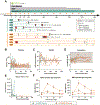CD154 blockade effectively controls antibody-mediated rejection in highly sensitized nonhuman primate kidney transplant recipients
- PMID: 39742504
- PMCID: PMC11797747
- DOI: 10.1126/scitranslmed.adn8130
CD154 blockade effectively controls antibody-mediated rejection in highly sensitized nonhuman primate kidney transplant recipients
Abstract
Current desensitization and maintenance immunosuppression regimens for kidney transplantation in sensitized individuals show limited ability to control the posttransplant humoral response, resulting in high rates of antibody-mediated rejection (ABMR) and graft failure. Here, we showed that anti-CD154 monoclonal antibody (mAb)-based immunosuppression more effectively controlled allograft rejection and humoral rebound in a highly sensitized nonhuman primate kidney transplantation model compared with tacrolimus-based standard-of-care (SOC) immunosuppression. Desensitization with an anti-CD154 mAb (5C8) and a proteasome inhibitor led to decreased donor-specific antibodies (DSAs) and disruption of lymph node germinal centers with reduction of proliferating, memory, and class-switched B cells as well as T follicular helper cells. After transplant, the nonhuman primates maintained on 5C8-based immunosuppression had significantly better survival compared with those maintained on SOC immunosuppression (135.2 days versus 32.8 days, P = 0.013). The 5C8-treated group demonstrated better suppression of DSAs after transplant, more robust suppression of B cell populations, and better induction of regulatory T cells. Fewer infectious and welfare complications, including viral reactivation and weight loss, were also observed with 5C8-based immunosuppression compared with SOC immunosuppression. Therefore, anti-CD154 mAbs may improve kidney transplant outcomes through better control of posttransplant immune responses. The superior efficacy of anti-CD154 mAb-based immunosuppression over tacrolimus-based SOC seen in this highly sensitized NHP transplant model suggests that anti-CD154 mAbs could potentially be used to desensitize and treat highly sensitized patients receiving kidney transplantation.
Conflict of interest statement
Competing interests
The authors declare that they have no competing interests.
Figures






Similar articles
-
Pretransplant Desensitization with Costimulation Blockade and Proteasome Inhibitor Reduces DSA and Delays Antibody-Mediated Rejection in Highly Sensitized Nonhuman Primate Kidney Transplant Recipients.J Am Soc Nephrol. 2019 Dec;30(12):2399-2411. doi: 10.1681/ASN.2019030304. Epub 2019 Oct 28. J Am Soc Nephrol. 2019. PMID: 31658991 Free PMC article.
-
Belatacept-Based Maintenance Immunosuppression Controls the Post-Transplant Humoral Immune Response in Highly Sensitized Nonhuman Primates.Kidney360. 2022 Oct 4;3(12):2116-2130. doi: 10.34067/KID.0001732022. eCollection 2022 Dec 29. Kidney360. 2022. PMID: 36591367 Free PMC article.
-
Fc-Silent Anti-CD154 Domain Antibody Effectively Prevents Nonhuman Primate Renal Allograft Rejection.Am J Transplant. 2017 May;17(5):1182-1192. doi: 10.1111/ajt.14197. Epub 2017 Feb 25. Am J Transplant. 2017. PMID: 28097811 Free PMC article.
-
Developments in immunosuppression.Curr Opin Organ Transplant. 2021 Feb 1;26(1):91-96. doi: 10.1097/MOT.0000000000000844. Curr Opin Organ Transplant. 2021. PMID: 33332922 Review.
-
The Inhibition of CD40/CD154 Costimulatory Signaling in the Prevention of Renal Transplant Rejection in Nonhuman Primates: A Systematic Review and Meta Analysis.Front Immunol. 2022 Apr 7;13:861471. doi: 10.3389/fimmu.2022.861471. eCollection 2022. Front Immunol. 2022. PMID: 35464470 Free PMC article.
Cited by
-
CD154:CD11b blockade enhances CD8+ T cell differentiation during infection but not transplantation.JCI Insight. 2025 Jun 9;10(11):e184843. doi: 10.1172/jci.insight.184843. eCollection 2025 Jun 9. JCI Insight. 2025. PMID: 40485581 Free PMC article.
-
Desensitization With Proteasome Inhibition and Costimulation Blockade Modulates the Xenoreactive Humoral Response in Nonhuman Primate Xenotransplantation.Xenotransplantation. 2025 Mar-Apr;32(2):e70045. doi: 10.1111/xen.70045. Xenotransplantation. 2025. PMID: 40259710 Free PMC article.
-
Cryopreserved Skin Transplantation in a Nonhuman Primate Model.Transplant Proc. 2025 Jul-Aug;57(6):1201-1204. doi: 10.1016/j.transproceed.2025.06.002. Epub 2025 Jun 25. Transplant Proc. 2025. PMID: 40571434
References
-
- Muduma G, Odeyemi I, Smith-Palmer J, Pollock RF, Review of the Clinical and Economic Burden of Antibody-Mediated Rejection in Renal Transplant Recipients. Adv Ther 33, 345–356 (2016). - PubMed
-
- Port FK, Wolfe RA, Mauger EA, Berling DP, Jiang K, Comparison of survival probabilities for dialysis patients vs cadaveric renal transplant recipients. JAMA 270, 1339–1343 (1993). - PubMed
-
- Stewart DE, Wilk AR, Toll AE, Harper AM, Lehman RR, Robinson AM, Noreen SA, Edwards EB, Klassen DK, Measuring and monitoring equity in access to deceased donor kidney transplantation. Am J Transplant 18, 1924–1935 (2018). - PubMed
-
- Lentine KL, Smith JM, Hart A, Miller J, Skeans MA, Larkin L, Robinson A, Gauntt K, Israni AK, Hirose R, Snyder JJ, OPTN/SRTR 2020 Annual Data Report: Kidney. Am J Transplant 22 Suppl 2, 21–136 (2022). - PubMed
MeSH terms
Substances
Grants and funding
LinkOut - more resources
Full Text Sources
Medical

